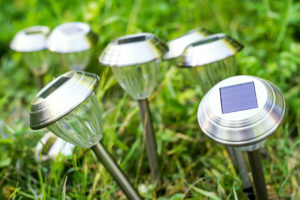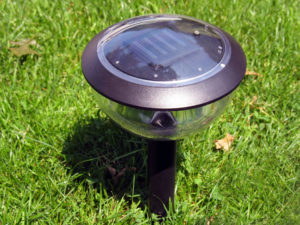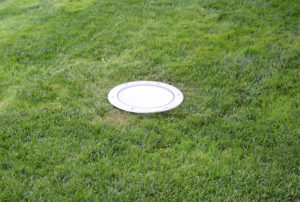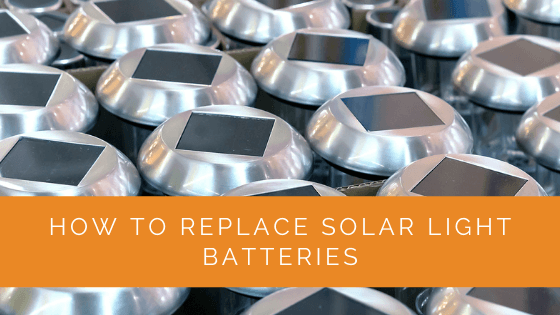Solar lights are a great way to illuminate your yard without any of the hassles. They are also environmentally friendly and cost-effective, but they do have one big downside: their batteries need to be replaced periodically. Here are some tips on how to replace solar light batteries quickly and efficiently.
Contents
- 1 Replacing Solar Light Batteries
- 2 Signs Your Solar Light Batteries Need Replacing
- 3 Tips for Keeping Your Solar Light Batteries Healthy
- 4 Solar Light Battery FAQs
- 4.1 How long do batteries last in my solar lights?
- 4.2 Can I use any type of battery in my solar lights?
- 4.3 Do I need to do anything special to dispose of old solar light batteries?
- 4.4 Why Do Solar Light Batteries Wear Out?
- 4.5 What are nickel-cadmium (NiCd) batteries?
- 4.6 What are nickel-metal-hydride (NiMH) batteries?
- 4.7 What are sealed lead acid (SLA) batteries?
- 4.8 What are lithium-ion (Li-ion) batteries?
- 4.9 What are primary cells?
- 4.10 Can I Mix NiCad And NiMH Batteries?
- 4.11 Can I Replace NiCad Batteries With NiMH?
- 4.12 Can I Replace NiMH Batteries With Li-ion?
- 4.13 Can I Use Regular Non-Rechargeable Batteries In My Solar Lights?
- 4.14 What are the different types of batteries for solar lights?
- 4.15 How long does it take to charge solar lights?
- 4.16 Is there anything else I need to know about replacing solar light batteries?
- 4.17 What are the components of solar lights?
- 4.18 What are the benefits of using solar lights?
- 5 Our Reviews of Solar Lights
- 6 Our Expertise in Solar Lights
- 7 Summing Up
Replacing Solar Light Batteries
#1 Remove the Solar Light Battery Cover
First, remove the solar light cover. This varies depending on your specific type of battery and will be different for every kind of fixture and rechargeable lithium-ion batteries versus lead-acid or alkaline ones.
Be sure to refer to the manufacturer’s instructions for how to do this properly in case any issues arise when removing it.
#2 Remove the Batteries
Next, locate where you can access the old batteries by looking underneath the cells if they are not already visible from above. Remove each one carefully using a screwdriver before putting them in an appropriate container that is lined with plastic bags so there is no risk of corrosion or spillage into other surfaces nearby while also preventing contact between liquids which could cause contamination problems down the road.
Carefully dispose of these out with your local recycling facility.
#3 Insert the New Batteries
Locate the new batteries you have purchased and place them in their respective cells with the terminals facing down, just as they were before.
#4 Replace the Solar Light Battery Cover
Put on your solar light cover again until it is securely fastened into position to complete this task successfully!
Signs Your Solar Light Batteries Need Replacing
 There are a few telltale signs that will let you know it’s time to replace your solar light batteries. One of the most common ones is if your solar lights start flickering or going out intermittently, this usually means the battery isn’t holding a charge like it used to.
There are a few telltale signs that will let you know it’s time to replace your solar light batteries. One of the most common ones is if your solar lights start flickering or going out intermittently, this usually means the battery isn’t holding a charge like it used to.
If you’re noticing your solar lights aren’t lasting as long as they used to, this could also be another sign that it’s time for a new set of batteries. Take into account how often the fixtures are being used and try to gauge whether or not the battery needs replacing by using these indicators.
Any corrosion on the battery cells is also an indication that it might need to be replaced soon, so keep an eye out for any changes in your solar lights to prevent any issues from arising.
Tips for Keeping Your Solar Light Batteries Healthy
One of the best ways to keep your solar light batteries healthy is by making sure they’re getting enough sunlight. If they’re not getting enough sun, then they won’t be able to charge properly and this could lead to decreased battery life.
Another thing you can do is make sure you’re using the correct type of battery for your specific fixtures. Not all lights use the same battery, so it’s important to make sure you’re using the right one.
Solar Light Battery FAQs
How long do batteries last in my solar lights?
This varies depending on many factors including how often it’s used and what kind of battery was chosen originally (some may last than others). A good rule of thumb is to replace your solar light batteries every two years on average.
Can I use any type of battery in my solar lights?
This also depends on the make and model of your solar light fixtures, but most usually it is advisable to stick with the same type of battery that was included when you first purchased them. Referring to the manufacturer’s instructions is always a good idea if there are any questions or doubts about what kind of battery should be used.
Do I need to do anything special to dispose of old solar light batteries?
It is best practice to carefully remove old solar light batteries and dispose of them properly at a recycling center. This will help prevent any negative environmental impacts from occurring. Be sure not to simply throw them in the trashcan!
Why Do Solar Light Batteries Wear Out?
There are a few reasons why solar light batteries might wear out faster than expected. One reason is that the solar lights aren’t getting enough sunlight to charge the battery. If they’re being used in an area that doesn’t get much sun, this could be the issue.
Another possibility is that the fixture itself isn’t working properly and needs to be replaced. Finally, it’s possible that the battery just isn’t holding a charge like it used to and needs to be replaced.
Any of these issues can cause your solar light batteries to wear out more quickly than anticipated, so it’s important to be aware of the signs and symptoms of each one. By catching them early on, you can prevent further damage from occurring and keep your solar lights up and running as they should.
What are nickel-cadmium (NiCd) batteries?
 A nickel-cadmium (NiCd) battery is a type of rechargeable electric cell that’s made with cadmium and nickel oxide hydroxide. This combination allows it to retain a charge for longer periods of time than other batteries, making it ideal for solar lights due to the infrequency they’re used in comparison to other devices.
A nickel-cadmium (NiCd) battery is a type of rechargeable electric cell that’s made with cadmium and nickel oxide hydroxide. This combination allows it to retain a charge for longer periods of time than other batteries, making it ideal for solar lights due to the infrequency they’re used in comparison to other devices.
What are nickel-metal-hydride (NiMH) batteries?
Nickel-metal-hydride (NiMH) batteries are a type of rechargeable electric cell that’s made with nickel and metal hydride. This combination allows it to be charged quickly and retain its charge for longer periods of time than other batteries.
What are sealed lead acid (SLA) batteries?
Sealed lead-acid (SLA) batteries are a type of rechargeable electric cell that’s made with an electrolyte paste and other materials to produce electricity. They’re typically used as backup power sources for solar lights, which is why they need replacing much less frequently than other types of batteries.
What are lithium-ion (Li-ion) batteries?
Lithium-ion (Li-ion) batteries are a type of rechargeable electric cell that’s made with lithium and other materials to produce electricity. They’re known for their high energy density, which is why they can be found in so many different devices today like solar lights.
What are primary cells?
Primary cells are a type of battery that can’t be recharged. They’re typically used in disposable devices, where they’re disposed of after their initial charge is depleted. This makes them less expensive and easier to maintain than other types of batteries.
Can I Mix NiCad And NiMH Batteries?
It’s not a good idea to mix different types of batteries. They need to be the same type and brand for your solar lights to work properly, especially if you’re using them as backup power sources like sealed lead acid (SLA) or lithium-ion (Li-ion).
Can I Replace NiCad Batteries With NiMH?
It’s possible to replace nickel-cadmium (NiCd) batteries with nickel-metal-hydride (NiMH), but it isn’t recommended. NiMH is a newer and better type of battery that you should be using instead of NiCd, so there’s really no reason for this replacement unless your solar lights aren’t working properly.
Can I Replace NiMH Batteries With Li-ion?
It’s possible to replace nickel-metal-hydride (NiMH) batteries with lithium-ion (Li-ion), but it isn’t recommended. Li-ion is a newer and better type of battery that you should be using instead of NiMH, so there’s really no reason for this replacement unless your solar lights aren’t working properly.
Can I Use Regular Non-Rechargeable Batteries In My Solar Lights?
This depends on the make and model of your solar light fixtures, but most usually it is advisable to stick with the same type of battery that was included when you first purchased them. Referring to the manufacturer’s instructions is always a good idea if there are any questions or doubts about what kind of battery should be used.
What are the different types of batteries for solar lights?
The most common type of battery for solar lights is the nickel-cadmium (NiCd) battery. However, some newer models might use a nickel-metal-hydride (NiMH) or lithium-ion (Li-ion) battery. It’s important to check your fixtures’ manual to see what kind of battery it uses before purchasing any replacements.
How long does it take to charge solar lights?
This also depends on many factors, but typically solar lights will be fully charged after being in direct sunlight for around eight hours. Some may take less time and others more, so it’s always a good idea to check the manufacturer’s instructions to get an accurate estimate.
Is there anything else I need to know about replacing solar light batteries?
 Always consult your solar light manufacturer before purchasing new batteries to make sure you are getting the right type and size. Not all solar lights use the same battery, so it’s important to double-check that what you’re getting will work for your specific fixture.
Always consult your solar light manufacturer before purchasing new batteries to make sure you are getting the right type and size. Not all solar lights use the same battery, so it’s important to double-check that what you’re getting will work for your specific fixture.
What are the components of solar lights?
The typical solar light consists of three main components: the solar panel, the battery, and the LED light. The solar panel collects energy from the sun and converts it into electricity to charge the battery.
The battery stores this energy until it’s needed to power the LED light. And finally, the LED light uses this energy to emit light for illumination purposes.
What are the benefits of using solar lights?
The biggest benefit of using solar light is its environmental friendliness. They do not require any wiring or outside power source, which makes them safe to use and less costly than other options out there.
They are also very eco-friendly since they can be placed anywhere without being connected to an electrical grid. Plus, you never have to worry about cords getting caught on anything causing damage like you might with traditional lighting choices such as halogen lighting fixtures for instance!
Our Reviews of Solar Lights
- Solar Christmas Lights: https://us.solarpanelsnetwork.com/blog/best-solar-christmas-lights/
- Solar Deck Lights: https://us.solarpanelsnetwork.com/blog/best-solar-deck-lights/
- Solar Disk Lights: https://us.solarpanelsnetwork.com/blog/best-solar-disk-lights/
- Solar Dock Lights: https://us.solarpanelsnetwork.com/blog/best-solar-dock-lights/
- Solar Driveway Lights: https://us.solarpanelsnetwork.com/blog/best-solar-driveway-lights/
- Solar Flagpole Lights: https://us.solarpanelsnetwork.com/blog/best-solar-flagpole-lights/
- Solar Flood Lights: https://us.solarpanelsnetwork.com/blog/best-solar-flood-lights/
- Solar Gutter Lights: https://us.solarpanelsnetwork.com/blog/best-solar-gutter-lights/
- Solar Hanging Lights: https://us.solarpanelsnetwork.com/blog/best-hanging-solar-lights/
- Solar Lamp Posts: https://us.solarpanelsnetwork.com/blog/best-solar-lamp-posts/
- Solar Path Lights: https://us.solarpanelsnetwork.com/blog/best-solar-path-lights/
- Solar Porch Lights: https://us.solarpanelsnetwork.com/blog/best-solar-porch-lights/
- Solar Post Cap Lights: https://us.solarpanelsnetwork.com/blog/best-solar-post-cap-lights/
- Solar Shed Lights: https://us.solarpanelsnetwork.com/blog/best-solar-shed-lights/
- Solar Spotlights: https://us.solarpanelsnetwork.com/blog/best-solar-spotlights/
- Solar Street Lights: https://us.solarpanelsnetwork.com/blog/best-solar-street-lights/
- Solar String Lights: https://us.solarpanelsnetwork.com/blog/best-solar-string-lights/
- Solar Wall Lights: https://us.solarpanelsnetwork.com/blog/best-solar-wall-lights/
Our Expertise in Solar Lights
At Solar Panels Network USA, we’re here to provide you with valuable information and support regarding solar lighting. With our experience and understanding of the solar lighting industry, our team of experts is prepared to assist you in finding the right lighting solution for your needs. Whether you’re interested in improving your outdoor spaces, conserving energy, or adopting a more sustainable approach, we’re well-equipped to help. Please feel free to contact us with any questions or inquiries.
Summing Up
Solar lights are a great option for outdoor lighting since they can be placed anywhere and require no wiring or other power sources to run. They’re also much more environmentally friendly than traditional light fixtures such as halogen lamps, which is another bonus of choosing solar!
When it comes time to replace your solar light batteries, make sure you look up the specifications on your specific fixture before purchasing new ones. Matching them with what was originally included will ensure that everything works properly without having any issues arise in the future.

